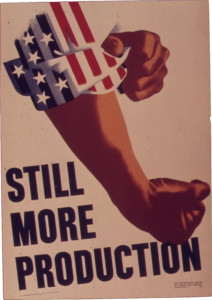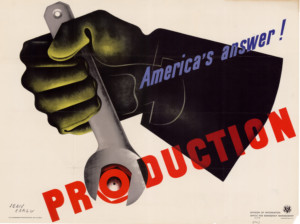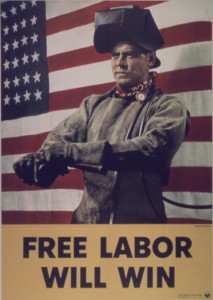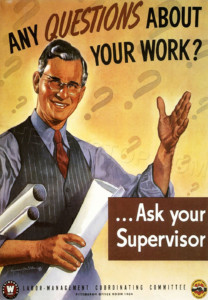 Training Within Industry and its modules Job Instructions, Job Relations, and Job Methods are well known. But (thanks to Mark Warren) I just recently learned about another module: Job Instructions for Second-Line Supervisors (nowadays called managers). This is a hierarchy level higher, and the goal is to support and guide the shop floor supervisors on how to use job instructions. Let me dig deeper:
Training Within Industry and its modules Job Instructions, Job Relations, and Job Methods are well known. But (thanks to Mark Warren) I just recently learned about another module: Job Instructions for Second-Line Supervisors (nowadays called managers). This is a hierarchy level higher, and the goal is to support and guide the shop floor supervisors on how to use job instructions. Let me dig deeper:
TWI
More on TWI Programs
 The TWI Program during World War II was very successful. Besides the Job Instructions, Job Methods, and Job Relations, a few other modules were developed, some of them internally. After the war, different institutions took over what the US government abandoned in December 1945. These follow-up institutions were the TWI Foundation and the TWI Inc. in the US; but it was also continued by the British TWI Service and the New Zealand TWI Service, and it was especially successful in Japan. Altogether, TWI was used in around seventy countries in 1960, although with quite different intensity and much less than when the US government used it through the war. This is the last in a series of five posts on TWI.
The TWI Program during World War II was very successful. Besides the Job Instructions, Job Methods, and Job Relations, a few other modules were developed, some of them internally. After the war, different institutions took over what the US government abandoned in December 1945. These follow-up institutions were the TWI Foundation and the TWI Inc. in the US; but it was also continued by the British TWI Service and the New Zealand TWI Service, and it was especially successful in Japan. Altogether, TWI was used in around seventy countries in 1960, although with quite different intensity and much less than when the US government used it through the war. This is the last in a series of five posts on TWI.
JM: Training within Industry – Job Methods
 Job Methods is the TWI module focusing on improving the workplace. The method is a basic four-step process focused on optimizing mechanical work. The underlying approach is good. The documents from 1945, however, put the improvement squarely on the shoulders of the supervisor.
Job Methods is the TWI module focusing on improving the workplace. The method is a basic four-step process focused on optimizing mechanical work. The underlying approach is good. The documents from 1945, however, put the improvement squarely on the shoulders of the supervisor.
My belief is that the workers should be involved much earlier and that the decision of what to improve would also benefit from more attention. But the basic method is still sound. The TWI people also saw this problem, but their management told them that it is “good enough.” Hence this module saw a lot of improvements after 1945. Yet, it was the smallest of the three main programs. Let me show you the TWI Job Methods in more details. This is the fourth in a series of five posts on TWI.
JR: Training within Industry – Job Relations
 Job Relations (JR) is one of the modules of the original Training within Industry (TWI) program. It was actually developed at Harvard using case studies, and for its time was groundbreaking in its idea that leadership can be learned! Like most TWI modules, it is sensible and useful. As with most TWI programs, it is focused on the front lines of the shop floor, and designed for first-line and second-line supervisors. The module is about good shop floor leadership.
Job Relations (JR) is one of the modules of the original Training within Industry (TWI) program. It was actually developed at Harvard using case studies, and for its time was groundbreaking in its idea that leadership can be learned! Like most TWI modules, it is sensible and useful. As with most TWI programs, it is focused on the front lines of the shop floor, and designed for first-line and second-line supervisors. The module is about good shop floor leadership.
While the program dates from World War II, it has lost none of its relevance, and can still help modern-day shop floor managers in becoming better leaders. The steps are not rocket science, but good common sense, and described with a clarity and brevity unusual for a management book. Below is a summary, mostly condensed from the “Job Relations 10 Hour Sessions Outline and Reference Material.” This is the third in a series of five posts on TWI.
JI: Training within Industry – Job Instructions
 Arguably the most successful module of Training within Industry is Job Instructions, or JI for short. JI has a precise focus on one topic: how to train your workers. The method is very simple and basic but works well.
Arguably the most successful module of Training within Industry is Job Instructions, or JI for short. JI has a precise focus on one topic: how to train your workers. The method is very simple and basic but works well.
Of course, there are some limitations. The process works well with pretty much any type of work, but it is best done one-on-one, as it was intended. It is not well suited for classroom teaching of larger groups; the trainer does need to invest time and attention to every individual student. But overall a very useful method. This is the second in a series of five posts on TWI.
Training within Industry – TWI – Oldies but Goldies
 Training within Industry – or TWI for short – was a US program during World War II. It significantly improved industrial production and helped the Allies to win the war. While the ideas date to the 1940s, they are still very relevant. In my view, they are pure gold if you have to manage a shop floor. It is to me the best overarching system for training and managing workers, and it significantly influenced Toyota.
Training within Industry – or TWI for short – was a US program during World War II. It significantly improved industrial production and helped the Allies to win the war. While the ideas date to the 1940s, they are still very relevant. In my view, they are pure gold if you have to manage a shop floor. It is to me the best overarching system for training and managing workers, and it significantly influenced Toyota.
While technology has changed a lot since 1945, people have not. The methods of TWI still work, and can really help you to improve. Even better, the original US government documents from 1945 are all in public domain. Let me introduce you to TWI. This is the first in a series of five posts on TWI.
